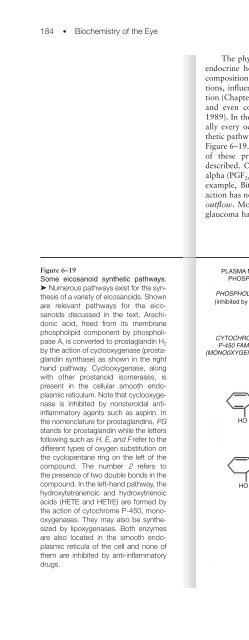(PROTEIN) WATER MOLECULE AMINO GROUP
(PROTEIN) WATER MOLECULE AMINO GROUP
(PROTEIN) WATER MOLECULE AMINO GROUP
Create successful ePaper yourself
Turn your PDF publications into a flip-book with our unique Google optimized e-Paper software.
184 • Biochemistry of the Eye<br />
Figure 6–19<br />
Some eicosanoid synthetic pathways.<br />
➤ Numerous pathways exist for the synthesis<br />
of a variety of eicosanoids. Shown<br />
are relevant pathways for the eicosanoids<br />
discussed in the text. Arachidonic<br />
acid, freed from its membrane<br />
phospholipid component by phospholipase<br />
A, is converted to prostaglandin H 2<br />
by the action of cyclooxygenase (prostaglandin<br />
synthase) as shown in the right<br />
hand pathway. Cyclooxygenase, along<br />
with other prostanoid isomerases, is<br />
present in the cellular smooth endoplasmic<br />
reticulum. Note that cyclooxygenase<br />
is inhibited by nonsteroidal antiinflammatory<br />
agents such as aspirin. In<br />
the nomenclature for prostaglandins, PG<br />
stands for prostaglandin while the letters<br />
following such as H, E, and F refer to the<br />
different types of oxygen substitution on<br />
the cyclopentane ring on the left of the<br />
compound. The number 2 refers to<br />
the presence of two double bonds in the<br />
compound. In the left-hand pathway, the<br />
hydroxytetranenoic and hydroxytrienoic<br />
acids (HETE and HETrE) are formed by<br />
the action of cytochrome P-450, monooxygenases.<br />
They may also be synthesized<br />
by lipoxygenases. Both enzymes<br />
are also located in the smooth endoplasmic<br />
reticula of the cell and none of<br />
them are inhibited by anti-inflammatory<br />
drugs.<br />
The physiological effects produced by these hormones, as with the<br />
endocrine hormones, are quite varied. They include control of ionic<br />
composition of the blood and blood pressure, modulation of lung functions,<br />
influence on cell proliferation, control of the inflammatory reaction<br />
(Chapter 9), mediation of gastrointestinal functions, wound healing,<br />
and even control of endocrine functions themselves (Watkins et al,<br />
1989). In the eye, eicosanoids are known to affect the function of virtually<br />
every ocular tissue (Bito, Stjernschantz, 1989). The principal synthetic<br />
pathways important to the eye for the prostaglandins are shown in<br />
Figure 6–19. However, the detailed mechanisms of many of the functions<br />
of these prostaglandins in the eye have not yet been adequately<br />
described. One important observation has been that prostaglandin F2<br />
alpha (PGF 2α) is able to lower the intraocular pressure of the eye (see, for<br />
example, Bito and Baroody, 1989). However, the mechanism for this<br />
action has not described although it has been isolated to the uveoscleral<br />
outflow. Moreover, the use of derivatives of this prostaglandin to treat<br />
glaucoma have been frustrated by the presence of side effects attributed<br />
PLASMA MEMBRANE<br />
PHOSPHOLIPID<br />
PHOSPHOLIPASEA2<br />
(inhibited by steroids)<br />
CYTOCHROME<br />
P-450 FAMILY<br />
(MONO0XYGENASES)<br />
HO<br />
HO<br />
12-HETE<br />
12-HETrE<br />
COOH<br />
COOH<br />
COOH<br />
ARACHIDONIC ACID<br />
OH<br />
OH<br />
ISOMERASE<br />
OH<br />
PGF2<br />
O<br />
O<br />
COOH<br />
CYCLOOXYGENASE<br />
(inhibited by NSAIDS)<br />
ISOMERASE<br />
O<br />
OH<br />
OH<br />
PGH2<br />
OH<br />
PGE2<br />
COOH<br />
COOH





